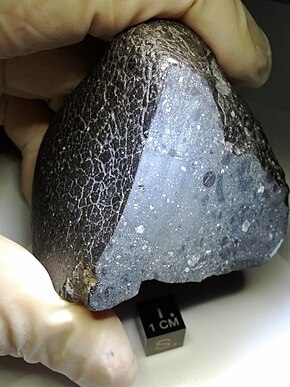
A Martian meteorite is a rock that formed on Mars, was ejected from the planet by an impact event, and traversed interplanetary space before landing on Earth as a meteorite. As of September 2020, 277 meteorites had been classified as Martian, less than half a percent of the 72,000 meteorites that have been classified. The largest complete, uncut Martian meteorite, Taoudenni 002, was recovered in Mali in early 2021. It weighs 14.5 kilograms and is on display at the Maine Mineral and Gem Museum.
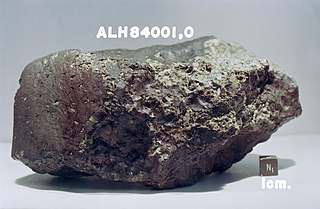
Allan Hills 84001 (ALH84001) is a fragment of a Martian meteorite that was found in the Allan Hills in Antarctica on December 27, 1984, by a team of American meteorite hunters from the ANSMET project. Like other members of the shergottite–nakhlite–chassignite (SNC) group of meteorites, ALH84001 is thought to have originated on Mars. However, it does not fit into any of the previously discovered SNC groups. Its mass upon discovery was 1.93 kilograms (4.3 lb).

An achondrite is a stony meteorite that does not contain chondrules. It consists of material similar to terrestrial basalts or plutonic rocks and has been differentiated and reprocessed to a lesser or greater degree due to melting and recrystallization on or within meteorite parent bodies. As a result, achondrites have distinct textures and mineralogies indicative of igneous processes.
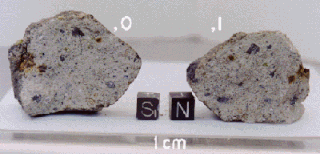
HED meteorites are a clan (subgroup) of achondrite meteorites. HED stands for "howardite–eucrite–diogenite". These achondrites came from a differentiated parent body and experienced extensive igneous processing not much different from the magmatic rocks found on Earth and for this reason they closely resemble terrestrial igneous rocks.

Tooting is an impact crater with volcanic features at 23.1°N, 207.1°E, in Amazonis Planitia, due west of the volcano Olympus Mons, on Mars. It was identified by planetary geologist Peter Mouginis-Mark in September 2004. Scientists estimate that its age is on the order of hundreds of thousands of years, which is relatively young for a Martian crater. A later study confirms this order of magnitude estimate. A preliminary paper describing the geology and geometry of Tooting was published in 2007 by the journal Meteoritics and Planetary Science, vol. 42, pages 1615–1625. Further papers have been published, including a 2010 analysis of flows on the walls of Tooting crater by A. R. Morris et al., and a 2012 review paper by P.J. Mouginis-Mark and J.M. Boyce in Chemie der Erde Geochemistry, vol. 72, p. 1–23. A geologic map has also been submitted in 2012 to the U.S. Geological Survey for consideration and future publication.

Angrites are a rare group of achondrites consisting mostly of Al-Ti bearing diopside, hedenbergite, olivine, anorthite and troilite with minor traces of phosphate and metals. The group is named for the Angra dos Reis meteorite. They are the oldest igneous rocks, with crystallization ages of around 4.56 billion years. Angrites are subdivided into two main groups, the quenched and plutonic angrites. The quenched angrites cooled rapidly upon the surface of the angrite parent body (APB), whereas the plutonic angrites cooled slower, deeper in the crust. The APB is thought to have been a similar size to the asteroid 4 Vesta.

Nakhlites are a group of Martian meteorites, named after the first one, Nakhla meteorite.

The Tissint meteorite is a Martian meteorite that fell in Tata Province in the Guelmim-Es Semara region of Morocco on July 18, 2011. Tissint is the fifth Martian meteorite that people have witnessed falling to Earth, and the first since 1962. Pieces of the meteorite are on display at several museums, including the Museum of Natural History of Vienna and the Natural History Museum in London.
Winonaites are a group of primitive achondrite meteorites. Like all primitive achondrites, winonaites share similarities with chondrites and achondrites. They show signs of metamorphism, partial melting, brecciation and relic chondrules. Their chemical and mineralogical composition lies between H and E chondrites.
This is a glossary of terms used in meteoritics, the science of meteorites.
Zachary D. Sharp is an American stable isotope geochemist. He is credited with the development of laser-based technology for measuring oxygen isotopes in silicates and oxides. His contributions include laser analyses of meteorites, paleoclimate reconstruction by oxygen and hydrogen isotope ratios, and analysis of isotopic composition of volcanoes, fossils, and forensic samples.

Northwest Africa 7325, also known as NWA 7325, is a unique igneous meteorite which crystallized as a basalt on a large asteroid or planetesimal approximately 4.56 billion years ago. It is classified as an ungrouped achondrite, and is notable for its green fusion crust and high-magnesium/low-iron composition. It was purchased from anonymous finders in a marketplace in Erfoud, Morocco in April 2012. The original find was composed of 35 fragments with a combined weight of approximately 345 grams (12.2 oz), however many additional fragments with a total weight of over 1,100 grams (39 oz) were subsequently recovered.
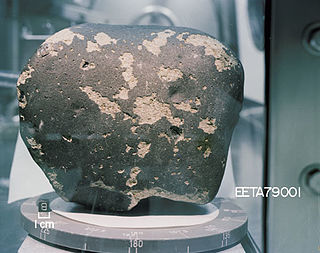
Elephant Moraine 79001, also known as EETA 79001, is a Martian meteorite. It was found in Elephant Moraine, in the Antarctic during the 1979–1980 collecting season.

Yamato 000593 is the second largest meteorite from Mars found on Earth. Studies suggest the Martian meteorite was formed about 1.3 billion years ago from a lava flow on Mars. An impact occurred on Mars about 11 million years ago and ejected the meteorite from the Martian surface into space. The meteorite landed on Earth in Antarctica about 50,000 years ago. The mass of the meteorite is 13.7 kg (30 lb) and has been found to contain evidence of past water alteration.
Caroline Smith is the Head of Earth Sciences Collections and Principal Curator of Meteorites at the Natural History Museum in London, UK. She specializes in geochemistry, meteorites, microscopy, mineralogy, and public outreach.

Karratha is an impact crater in the Memnonia quadrangle of Mars. It was named after the town of Karratha, Western Australia, in 2021.

Dampier is an impact crater in the Memnonia quadrangle of Mars. It was named after the town of Dampier, Western Australia, in 2021.
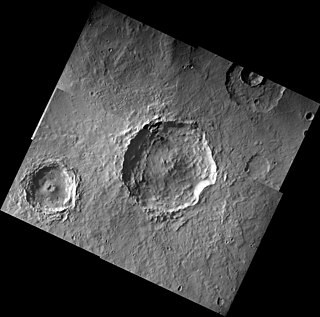
Khujirt is an impact crater in the Memnonia quadrangle of Mars. It was named after the district of Khujirt, central Mongolia, in 2021.
